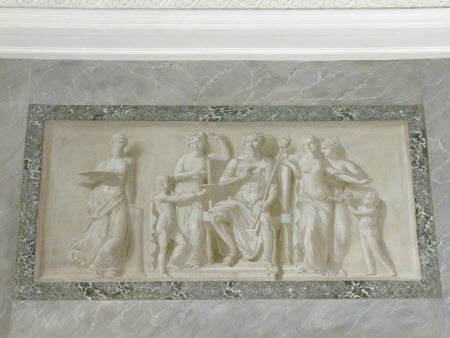Bacchus enthroned served by Boys with Attendant Bacchantes
attributed to George Barret the Younger (London 1767 - London 1842)
Category
Art / Oil paintings
Date
c. 1812
Materials
Oil on canvas
Measurements
876 x 1816 mm (34 1/2 x 71 1/2 in)
Order this imageCollection
Attingham Park, Shropshire
NT 609086
Caption
This is one of three grisailles (monochrome painting simulating sculpture), which were all later additions to the Entrance Hall at Attingham. When the painted marbling of the Entrance Hall was restored, two concealed signatures of W & G Barret were discovered, one dated 1812. It is not clear whether these were two sons of the popular Irish-born landscape painter George Barret Senior (1728/32 – 1784), or two decorative painters, of which otherwise nothing is known. Bacchus was one of the twelve Olympian gods – the god of wine and intoxication. He was the son of Zeus and Semele, snatched prematurely from his mother’s womb when she was burnt to death by a thunderbolt from his father. He is holding a Thyrsus, a wand tipped with a pine cone (an ancient fertility symbol) in his left hand.
Summary
Oil painting on canvas, Bacchus enthroned served by Boys with Attendant Bacchantes, attributed to William Barret and George Barret the younger (London c.1767 - London 1842), circa 1812. Seven full-length figures: central figure of Bacchus enthroned holding a Thyrsus (a wand tipped with a pine cone – an ancient fertility symbol) in his left hand, two lightly draped female attendants on the right and on the far right a small boy holding up a large dish of grapes, on the left are two further female attendants and a youth between them offering a drink to Bacchus. A grisaille overdoor.
Provenance
2nd Lord Berwick collection; bequeathed to the National Trust with the estate, house and contents of Attingham by Thomas Henry Noel-Hill, 8th Baron Berwick (1877-1947) on 15th May 1953.
Credit line
Attingham Park, The Berwick Collection (National Trust)
Makers and roles
attributed to George Barret the Younger (London 1767 - London 1842), artist attributed to William Barrett, artist previously catalogued as attributed to Robert Fagan (1761 - Rome 1816), artist

